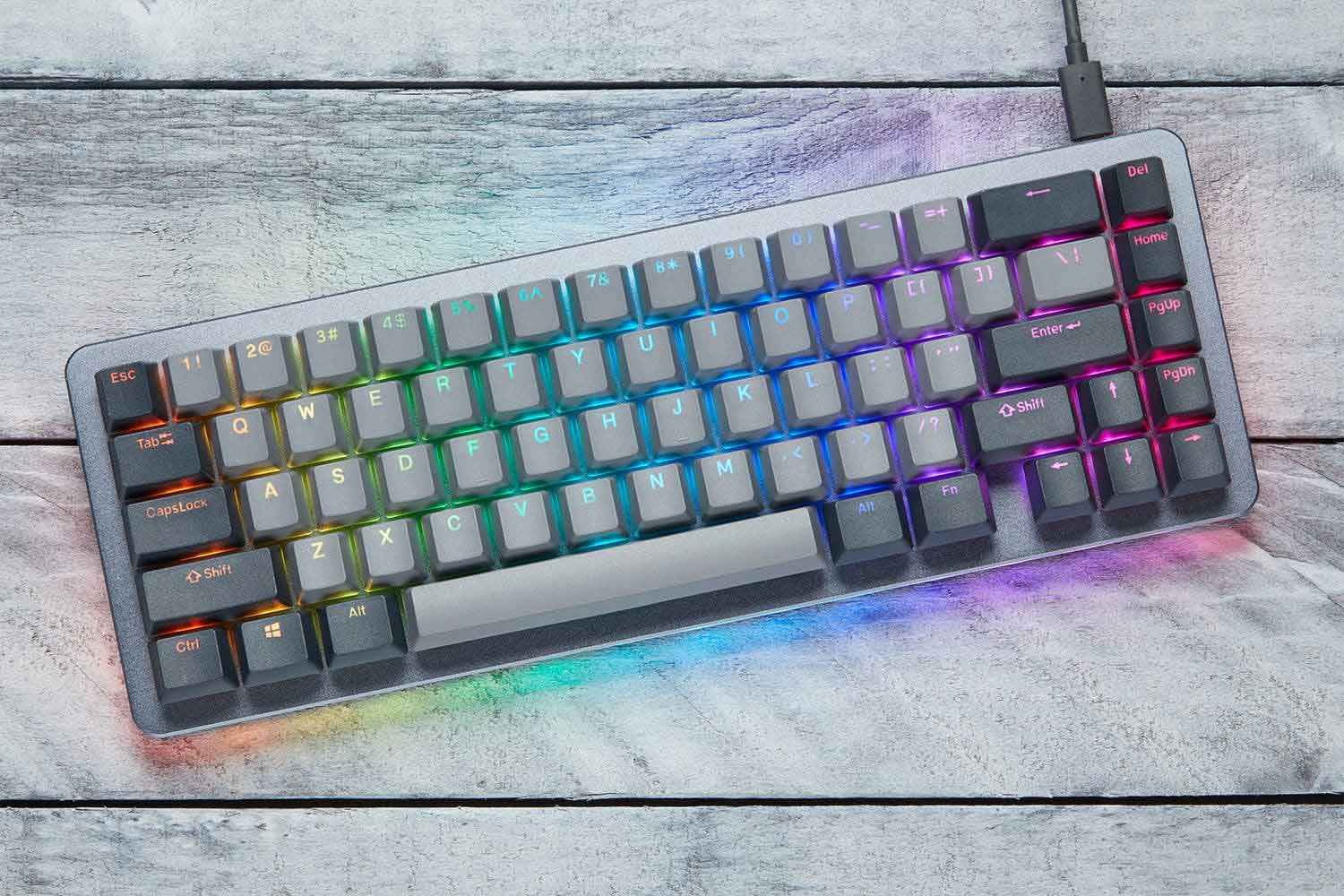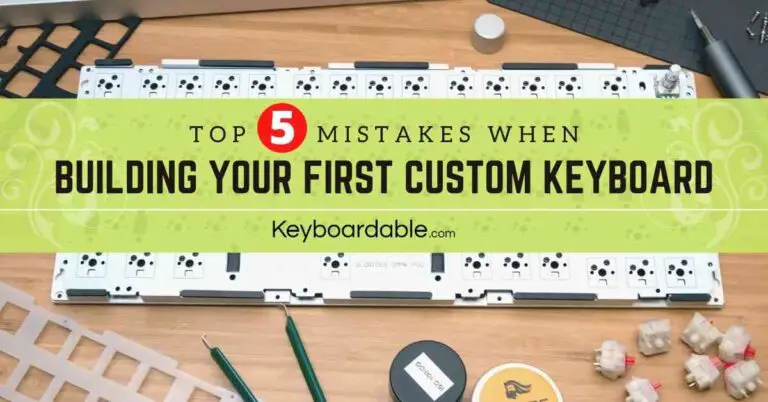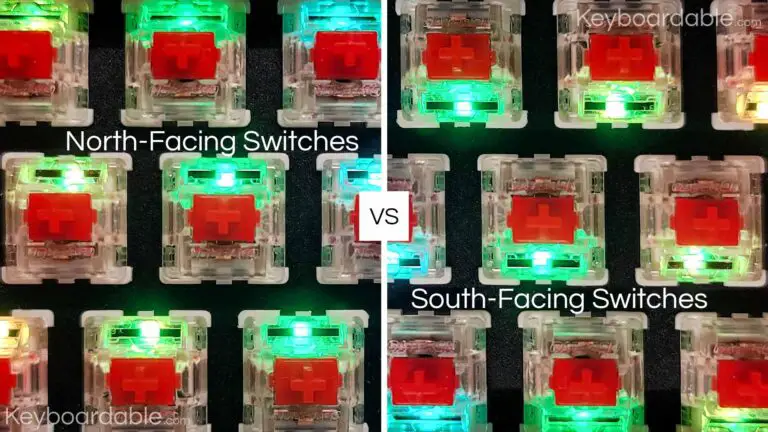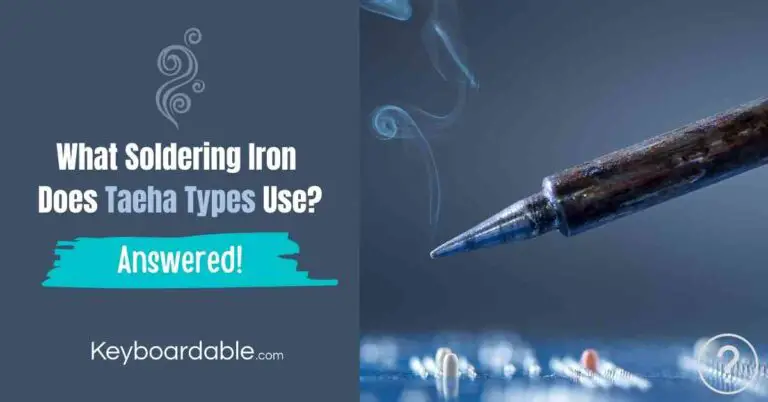Complete Guide to 65% Keyboards and the Best 65% Keyboard for You
Keyboardable is supported by our community. When you buy through links on our site, we may earn an affiliate commission.
As an Amazon Associate, Keyboardable earns from qualifying purchases.
65% keyboards are quickly becoming one of the most popular layouts for mechanical keyboard enthusiasts. Their compact form factor and functionality make them a great addition to any desk setup.
What is a 65% Keyboard?
The 65% keyboard layout is a compact layout that is smaller than a full size or tenkeyless keyboard, as it has 65% of the keys a full-sized keyboard with a numpad. 65% keyboards include dedicated arrow keys and an extra row of keys along the right-hand side of the board. The keys included in the extra row are often keys like page up, page down, home, or delete that would normally be in the area above the arrow keys in a standard full-size keyboard layout.
How Many Keys Are on a 65% Keyboard?
A 65% keyboard usually contains 67-68 keys. This number varies a little depending on the company that manufactures the board, as some of them have 1.5u keys between the spacebar and left arrow key instead of using 3 1u keys. (1u is the size of a standard letter key, often referred to as an “alpha key” on a keyboard. All key sizes are measured in relation to a 1u key.)
How Many Switches Do You Need for a 65% Keyboard?
A 65% keyboard will usually use between 67-68 switches to correspond with the number of keys. Some keyboards however allow for a split spacebar. If your board does and you want to use a split spacebar layout, you’ll need 1-2 additional switches for a total of 70 switches. Even if you don’t need a split, spacebar, it’s usually a safe bet to have a couple of extra switches on hand, so you’re still best-off buying 70 switches for your 65% keyboard.
What Keys are Missing on a 65% Keyboard?
65% keyboards don’t include the numpad or the F1-12 row of keys, so if those are features you need, you’re best off looking at a 75%, 86% ten-keyless, or full-size keyboard.
As for the other missing keys, it varies depending on the particular brand. The insert, delete, page up, page down, print screen, and home buttons vary on which ones are and aren’t included. Often the page up and page down buttons are included, and the inclusion of the other keys varies from company to company.
The good news is that you can usually change what your keys do using software, so if you had your heart set on having a print screen button, but your keyboard doesn’t include one, you can change one of the ones you use less often.
65% keyboards also usually lack dedicated media keys. Many 65% keyboards, however, include this media controls in a function layer. The keys to access this vary depending on your model of keyboard. You could also remap keys to use for media control or set custom hotkeys.
What is the Difference Between a 60% and 65% Keyboard?
One of the major differences between a 60% and a 65% keyboard is the addition of dedicated arrow keys. Obviously, these are super useful for many people, especially if you work with a lot of tables or spreadsheets.
The other major difference is the inclusion of a few additional function keys along the right-hand side of the keyboard, usually around 4 of them. These provide quick and easy access to additional keyboard functionality without having to store it in a layer or create a custom hotkey for it.
How Many Stabilizers Does a 65% Keyboard Use?
A 65% keyboard uses 4 to 5 stabilizers. Most will use 4 stabilizers, however, 65% keyboards that use a right shift key larger than 1.75u will need an additional stabilizer for that key. Usually, most 65% keyboards will only have a stabilizer on the left shift, spacebar, enter, and backspace key on US layouts.
Who is a 65% Keyboard Best for?
A 65% keyboard is best for those that enjoy the compact layout of a 60% keyboard, but still require dedicated arrow keys. With only 1 additional row of keys, it’s still a very small and clean layout that works well on minimalist desk setups or for those who are short on space without compromising on functionality. They’re also pretty portable, so if you need to travel with your mechanical keyboard often, this layout is a good choice.
The compact keyboard layout of a 65% also means you have more space for your mouse. If you use your mouse frequently, this can make a big difference in your ergonomics, allowing you to use more of your arm for wider movements, which reduces strain on your wrist and the stress on your carpal tunnel, elbow, and shoulder.
65% keyboards aren’t a good choice for those who require the function row or the numpad, as a 65% layout lacks these keys. There is always the options of getting a dedicated numpad, but for many that kind of defeats the purpose of wanting to get a compact keyboard in the first place.
Are 65% Keyboards Good for Gaming?
A 65% keyboard does make a good gaming keyboard. For many games, the addition of arrow keys compared to a 60% keyboard is usually helpful. A 65% keyboard really isn’t recommended though if you’re planning on playing MMO’s like World of Warcraft as those usually require the use of the F1-F12 keys to cast spells and abilities with. First-person shooters, MOBA’s, or other RPG’s usually work well with a 65% layout so you’ll be just fine for those types of games.
Are 65% Keyboards Good for Programming?
65% keyboards are great for programming and are better for programmers than 60% keyboards because of the addition of the arrow keys. Many programmers make frequent use of the arrow keys while they work. In most 60% keyboards, you are required to use a function layer to access the arrow keys, so having dedicated, physical keys makes it much faster to navigate through lines of code.
65% keyboards are also compact enough that you can commute with your keyboard if needed, or bring it with you to a cafe or a chill space at the office to work. It’s much easier to carry around than a full sized or ten-keyless keyboard with all of the essential functionality you need for programming.
Are 65% Keyboards Good for Writers?
A good keyboard is arguably the most important physical tool in a writer’s arsenal because of the fact that the majority of your day as a writer is spent typing and navigating text-based documents, which makes 65% keyboards great for writers. The dedicated arrow keys on a 65% keyboard mean you can quickly and easily navigate around lines of text on a document or change pages without needing to access them through a function layer.
Another thing that makes 65% keyboards great for writers is how compact they are. They’re super easy to bring to your writing group, the cafe, the park, the library, or really anywhere you feel most comfortable writing.
Are 65% Keyboards Good for Typing?
65% keyboards are better than 60% keyboards for those who type a lot because of the addition of dedicated arrow keys, making selecting words and lines of text with hotkeys combinations instead of reaching for your mouse or trackpad quick and easy.
Like with any mechanical keyboard, the typing experience on a 65% keyboard is arguably the best typing experience you can get. Mechanical switches offer a better feel and typing experience than standard chiclet scissor switches or rubber membrane keyboards, and are able to be completely customized to your preference, making them excellent for typists.
Best 65% Keyboards of 2021
While there are a lot of 65% keyboards on the market, some are definitely better than others. In this section, we’ll cover the best 65% keyboards on the market for 2021.
Drop Alt – Best 65% Floating Key Keyboard
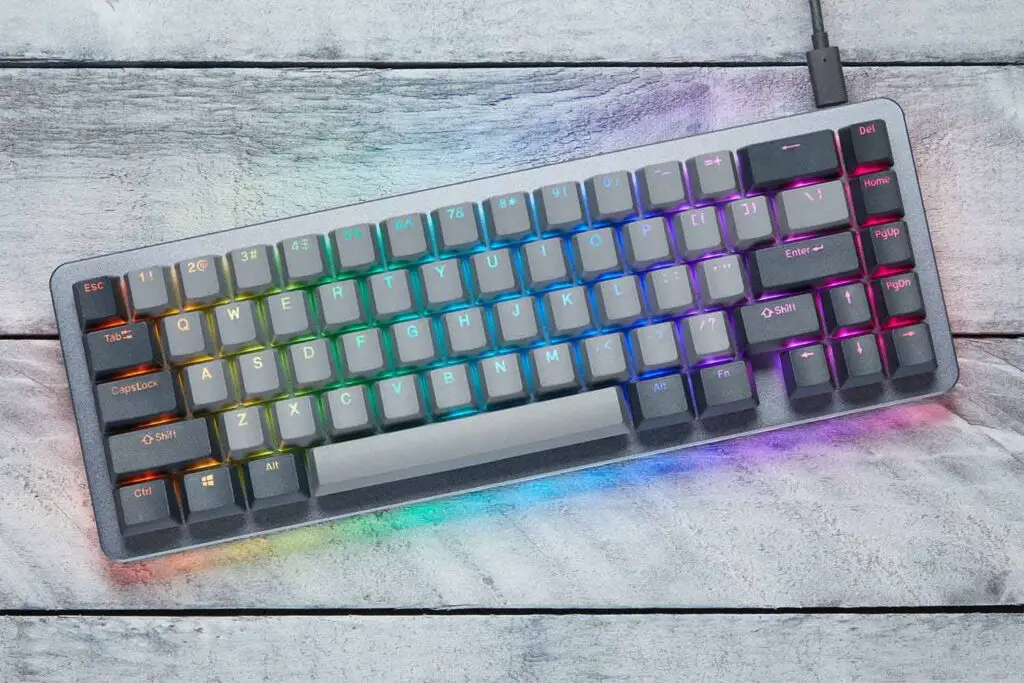
The Drop Alt is arguably on the best known 65% keyboards on the market. It’s clean aesthetic instantly makes it a centerpiece in a minimalist desk setup. If you’re looking for a floating key design, you will be hard-pressed to find a cleaner one than the Alt, which is why it earned our title of best floating key 65% keyboard.
Floating Keys
One of the biggest draws of the Drop Alt is the clean, minimalist, floating key design. Drop’s floating key design makes use of an integrated plate design, meaning the top housing of the case doubles as the plate. This generally results in a harder bottom out, so it’s important to keep in mind.
In a floating key keyboard, the top housing of the switches sits above the case instead of being housed inside the case. This means it looks like the keycaps float above the case, hence a “floating key” keyboard. This does also mean that more dust will find its way into your keyboard and switches because they’re more exposed than with a more traditional case design. Because of this, you’ll need to dust your Drop Alt off pretty often to keep it nice and clean.
Floating keys can also significantly change the sound profile of your switches, so it’s something to keep in mind when you’re listening to switch sound tests online to decide on your switches. Just like the case material surrounding your switches affects the sound, a lack of material does as well, so make sure to listen specifically to sound tests on the Drop Alt.
Switch Options and Stabilizers
The Drop Alt offers 6 stock switch options (two Cherry MX switch options, two Drop Halo switch options, and two Kaihua switch options), or a “barebones” option that doesn’t include the switches or the keycaps. Your stock options are:
- Cherry MX Blue RGB
- Cherry MX Brown RGB
- Drop Halo Clear
- Drop Halo True
- Kaihua Speed Silver
- Kaihua Box White
It’s an interesting lineup of switches to choose from. If you aren’t a fan of any of these options, your best bet is to get a barebones version and pick up the keycaps separately if you had your heart set on the stock ones (they do sell them separately here). It would be great to see an option with the Drop Holy Pandas at some point, but since Drop currently has a very hard time keeping them in stock, it’ll likely be a while before we see an option for any of their keyboards to come with them.
The Drop Alt also comes with snap-on, plate mounted stabilizers. Your mileage may vary with the stabilizers, as many in the keyboard community really dislike the stock stabilizers that come on the Alt. The good news is if you end up disliking them as well, they’re relatively affordable to replace with any other plate mounted cherry stabilizers.
What we like about the Drop Alt:
- Hotswap
- Commercial product with ample reviews…you know exactly what to expect when you buy a Drop Alt
- Comes stock with PBT keycaps
- Two USB-C ports…one on either back side of the case
- Customizable RGB backlighting
What we don’t like about the Drop Alt:
- The feet
- It’d be great if there were more switch options
- Stabilizers are generally considered to be low quality
Final Thoughts on the Drop Alt
The Drop Alt is a solid choice for a 65% keyboard, and looks great with almost any setup. The fact that it comes stock with PBT keycaps means you won’t have to try and find a different keycap set to replace it with.
Keychron K6 – Best 65% Keyboard for Mac and iOS Users, Best 65% Keyboard for Travel
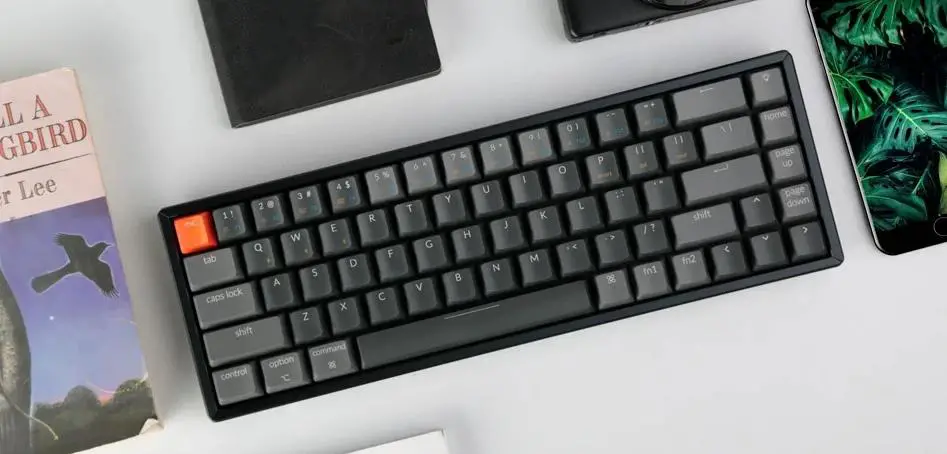
The Keychron K6 wins the title of best 65% keyboard for Mac and iOS users AND best 65% keyboard for travel on this list. This keyboard’s native Apple device support at the flip of a switch, the inclusion of additional keycaps to support Apple users, and the great Bluetooth connectivity make it easy to use with your Mac computer or an iPhone or iPad. While it has some good heft to it, it’s not so heavy that it would make traveling with it particularly cumbersome compared to other keyboards.
Keychron makes some solid boards at affordable prices, and the Keychron K6 is no different. With a mind-boggling number of configurations, there’s a K6 setup for just about everyone.
Flawless Mac and iOS Compatibility
The Keychron arguably has some of the best Mac and iOS compatibility on the mechanical keyboard market. What makes their keyboards so special is the switch on the side to swap between Mac/iOS and Widows/Android (and Linux too!) keyboard layouts, ensuring that your bottom row of keys will always have the right functionality no matter what device you’re on.
The other reason the Keychron K6 wins the title of best Mac and iOS keyboard is the inclusion of extra keycaps to use with the Apple symbols on them. In fact, these Apple keycaps are actually the ones that come installed on the board by default, so if you primarily use Apple devices, you won’t have to switch them out for the Windows ones included in the package.
Best of all, swapping them out is easy with the included wire keycap puller. You probably won’t be swapping them out often, but it’s still a really nice thing to include when extra keycaps come with the keyboard.
Connect to All of Your Devices
All models of the Keychron K6 come standard with both wired connection via USB-C and wireless connection to up to 3 paired Bluetooth devices. Pairing a Bluetooth device is easy, and swapping between devices on the fly is quick by pressing the function key and Q, W, or E. There isn’t a noticeable increase in latency when using it as a wireless keyboard compared to using the wired connection, and during our testing, Keychron’s wireless worked well enough to game on without any issues.
The wireless is also a really nice feature that makes the Keychron K6 a great keyboard for traveling. You don’t have to break out the cable to connect to your device while you’re at the cafe or library, which means one less cable to worry about coiling when you pack up.
The battery life on the K6 is also great. Provided you turn the backlighting off, you can get up to 240 hours of use on a charge. The K6 will automatically enter sleep mode after 10 minutes of inactivity while on Bluetooth connection, so you don’t have to worry about turning it off if you stop working to chat or eat for a bit. When your battery runs out, it’ll take around 3 hours to charge, so simply plugging it in at night a couple of times a week should be more than sufficient to keep it supplied with more than enough power for all of your typing needs.
The only noticeable connectivity issue honestly isn’t an issue with the connectivity at all, but with the placement of the USB-C port on the keyboard. The USB-C port, like with many of Keychron’s keyboards, is placed on the left side of the keyboard instead of the more conventional spot on the back. This can make it difficult to properly route your cable, or use custom cables, as they’ll stick out more than the included L cable.
Keychron K6 Keycaps and Backlighting
The Keychron K6 comes stock with ABS keycaps featuring shine-through, laser-etched legends. The legends are a thin font and really clean, making the overall look very appealing and sophisticated. The alpha keys have uppercase legends, while the modifiers have all lowercase font, providing a nice contrast between them in addition to the contrasting colors of the alpha and modifier keycaps.
The thin font also plays well with the LED backlighting. The backlighting comes in two versions, white and RGB, and honestly, it’s worth the extra $10 to go with the RGB. It’s a really understated RGB that bathes the legends in color and peaks through a little in between the keycaps but isn’t overly bright. In normal lighting, it looks like the legends have brightly colored, dye-sublimated legends.
There are a decent number of RGB lighting effects, accessed by pressing the lighting key in the top right corner and using the arrow keys. Unfortunately, this lighting key isn’t reprogrammable, so if you don’t change your RGB often, it’s somewhat of a wasted key.
The only real downside for these keycaps is that they aren’t PBT. It is significantly harder to make shine-through PBT keycaps with this delicate of a font, so it would completely change the look to swap it to PBT keycaps, but having a PBT configuration option would be nice. Keychron does make a retro Apple PBT keycap set for the K6 keyboard, so it’s honestly a mystery why they don’t have those as a configuration option on the K6’s purchase page.
What we like about the Keychron K6:
- Clean RGB that isn’t overkill
- Mac/iOS and Windows/Android compatibility at the flip of a switch and extra keycaps for both layouts included (with a wire keycap puller!)
- Hot-Swappable Models available
- Reliable Gateron mechanical switches provide a good value to performance ratio
- Great Bluetooth connectivity and USB-C connection
- Flip out feet for different typing angles
- Many configuration options available to fit almost every budget
- Good battery life when using wireless
What we don’t like about the Keychron K6:
- The stock ABS keycaps look nice, but a configuration with PBT caps would be great
- The USB-C port is on the side of the board, which can be frustrating for cable routing or using custom cables
- The use of LK switches in the optical switch version really limits your switch choices
Final Thoughts on the Keychron K6
The Keychron K6 is a great keyboard all around, but it really shines for Mac users who are often underserved in the mechanical keyboard market. The fact that it’s light enough to carry around easily and the great Bluetooth connectivity options and long battery life make it an excellent keyboard for traveling with. It comes with an array of configuration options that will let it fit almost any budget, so it’s definitely worth looking at if you’re searching for a good 65% keyboard, especially since it’s so easy to mod and upgrade the hot-swappable version.
Durgod Hades 68 – Best 65% Gaming Keyboard
While any of the keyboards on the list could be used for gaming, the Durgod Hades 68 is coming in as our top 65% gaming keyboard pick. The Hades 68 is a compact gaming keyboard with a rather classic PC gamer RGB aesthetic. Doubleshot, shine-through PBT keycaps show off its RGB backlight well, and the 13 different switch options make it easy to find something you like.
Pre-built and Ready to Play
The Durgod Hades 68 is a solid keyboard choice for gamers looking for a 65% keyboard. It has doubleshot, shine-through PBT keycaps so those WASD keys won’t get shiny from the heavy use that gamers usually put them through. The keyboard also has the black and RGB gaming look that a lot of gamers like packed into an aluminum case unline the plastic one you’ll find on a lot of others in this price range. (There’s also a white model that looks really nice if you prefer that aesthetic.)
It’s important to note, however, that this isn’t a keyboard for those that want to lube their switches and tune their stabs until their spacebar makes that perfect thock unless you’re willing to commit to de-soldering and re-soldering the PCB. This is fine for most gamers who don’t want to be bothered with all of the things that keyboard enthusiasts do to fine-tune their keyboards.
If you’re a keyboard enthusiast who is willing to commit to some soldering, you’ll find a good base to work with. The aluminum case and PBT keycaps already make this a solid choice at this price point. With some switch lubing, stabilizer work, etc, you can take the already solid Durgod Hades 68 and make it a great board.
Switch Options
To say the Durgod Hades 68 has a lot of switch options would be an understatement. You can choose from a whopping 13 different switches for this keyboard, including the popular Kailh Box Jades, which is an uncommon stock choice for a keyboard.
- Cherry Black
- Cherry Blue
- Cherry Brown
- Cherry Red
- Cherry Silent Red
- Cherry Speed Silver
- Gateron Black
- Gateron Blue
- Gateron Brown
- Gateron Red
- Gateron Silent Brown
- Gateron Yellow
- Kailh Box Jade
What we like about the Durgod Hades 68:
- Aluminum case
- Doubleshot shine-through PBT keycaps
- 13 different switch options mean there is something for everyone
- Two cables included
- RGB backlight
What we don’t like about the Durgod Hades 68:
- Not hot-swappable
- Doesn’t have bluetooth
Final Thoughts on the Durgod Hades 68
The Durgod Hades 68 is a great 65% keyboard for gaming, and honestly just a great 65% keyboard in general. PBT keycaps, aluminum case, a ton of switch options…this keyboard has a lot of things going for it. The only real downsides with this board are the fact that the PCB isn’t hot-swappable and the lack of Bluetooth, which isn’t really a deal-breaker. We’d love to see Durgod add these two features to a later release of this keyboard!
Durgod Fusion – Best Retro 65% Keyboard
If you’re looking for a retro-style 65% keyboard, look no further than the Durgod Fusion. While it may have a retro aesthetic, this board still offers the modern convenience of USB-C, wireless, and Bluetooth connection. It also features PBT keycaps.
Retro Vibes
The Durgod Fusion is designed to feel like the classic retro mechanical keyboards from back in the day. This starts with the case, where they’ve chosen to use plastic to emulate older keyboard cases. If you’re looking for a faithful recreation, this was a great decision. If you’re someone who prefers the sound and heft of an aluminum case though, you may find yourself disappointed.
The switch choices are also reflective of classic mechanical keyboards. This keyboard only comes stock with Cherry switch options. It would have been nice to see some other switch options for those that wanted the retro look without the “retro” feel of Cherry switches. Some Gateron switches would have been a sensible choice to include.
If you want to swap out the stock Cherry switches, you’ll have some soldering work to do, as the Durgod Fusion isn’t hot-swappable. Not everyone sees this as a deal-breaker, but it can be inconvenient if you want to lube the stock switches it came with.
Connection Options
The Durgod Fusion has three options for connecting it to your devices. The first is a wired connection via USB-C. The second is via Bluetooth. The third is via a wireless USB dongle that you plug into your device. While most people should be just fine connecting their device via cable or Bluetooth, including the option of having a wireless dongle is nice in case your PC doesn’t have Bluetooth or you are using a lot of Bluetooth devices at the same time (which can slow down the Bluetooth signal).
What we like about the Durgod Fusion:
- Wired USB-C and wireless connection via Bluetooth and Wireless dongle
- Doubleshot PBT keycaps
- Awesome retro aesthetic
What we don’t like about the Durgod Fusion:
- Not hot-swappable
- Non-Cherry switch options would be nice
- No backlighting
Final Thoughts on the Durgod Fusion
The Durgod Fusion is a really cool looking retro style board that captures the feeling of the boards of yesteryear. The wired and wireless connections make it convenient to use with all of your gear. While it would be nice to see the board have a hot-swappable PCB and non-Cherry switch options, this is still a solid board.
Womier K66 Crystalline – Best 65% Keyboard for RGB Lovers
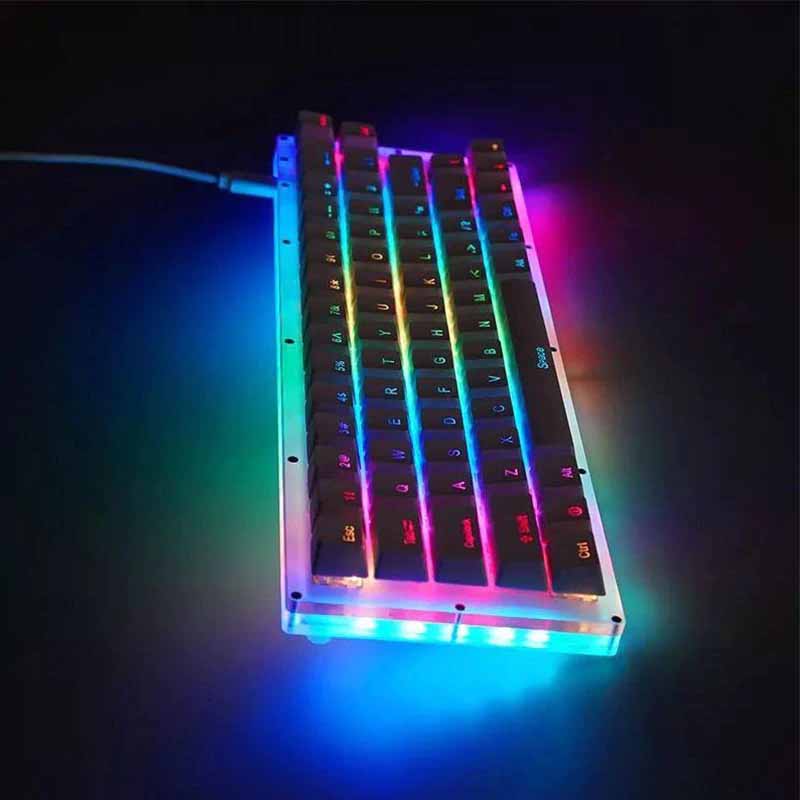
The Womier K66 Crystalline is a keyboard that will be the focal point of your desk setup. The spectacular RGB effects on this keyboard really shine above any other feature, despite the fact that this budget-friendly pick packs a punch with its hot-swappable PCB. The RGB LEDs showing through the frosted acrylic case make it a real show-stopper, which is why we’ve named it the best 65% keyboard for RGB lovers.
Crank the RGB to 11
It’s hard to pack more RGB LEDs into a keyboard than Womier managed to with the K66 Crystalline. Not only is there RGB backlighting for each key, but the entire case is made of frosted acrylic and filled with even more RGB LEDs to turn the entire keyboard into an illuminated spectacle. This includes RGB underglow, which is usually a feature you’d see on much more expensive boards.
The case LEDs and the key backlight LEDs have separate settings so you can adjust their settings independently of the other to really tune in on the look you want. The K66 also features caps lock indication by lighting that key up red, even if the RGB is turned off.
Check out this video from :3ildcat to see all of the RGB effects in action:
Hot Swap on a Budget
One of the most notable things about the Womier K66 Crystalline other than the RGB light show worthy of a theme park is the fact that it’s a hot-swappable board. If you don’t like either of the three Gateron switch options included, or you want to be able to take your switches out easily to lube and film them, this board is a great option and much more affordable than some of the other hot-swappable boards on the list.
Fewer Keys
It is important to note that the Womier K66 has 1 less key than the average of 67-68 keys than most 65% keyboards have. In fact, the brand officially calls it a 60%. However, the inclusion of two extra function keys and dedicated arrow keys secured its honorary spot as a 65% keyboard.
Wommier K66 Keycaps
The Womier K66 comes stock with white, OEM profile, shine-through ABS keycaps. The legends are towards the bottom of the keycap face instead of on the top portion like you’d usually see, which gives them a unique look. This is also intended to take full advantage of the LED lighting, as the PCB on this keyboard is setup for south-facing switches. This means the LED is hitting the bottom half of the switch instead of the top half, so having the legends on the bottom of the switch allows the light to shine through better.
PBT keycaps would have been a really nice addition to this keyboard instead of ABS keycaps, but at this price point, it’s difficult to argue with the decision to use ABS. Adding your own PBT keycaps would really boost this board to the next level, and wouldn’t be terribly difficult. Pudding keycaps would be a particularly good fit for this board to really play up the RGB.
What we like about the Womier K66 Crystalline:
- Clean design that allows the RGB LEDs to be the star of the show
- Hot-swappable
- Reliable Gateron stock switches provide a good value to performance ratio
- USB-C port means fast connection and compatibility with custom cables
- Did we mention the amount of RGB?
What we don’t like about the Womier K66 Crystalline:
- Including 2 more keys above the right arrow key would have been nice
- No wireless
- PBT keycaps would have been nice even if they increased the cost a bit
Final Thoughts on the Womier K66 Crystalline
Overall, the Womier K66 Crystalline is a beautiful board with a lot to offer, especially at the price point. You get a lot of RGB bang for your buck as well if that’s something you’re into, and honestly, even if it’s not, this board is really aesthetically pleasing with the lighting turned off. Gateron switches perform well and are a good fit for a budget mech like this, and the fact that this board is hot-swappable makes it easy to mod the switches or change them out for nicer ones down the road.
NK65 Entry Edition – Best 65% Keyboard for Beginner Builds

There’s a lot to love about the NK65 Entry Edition. For starters, the price is right. $95 will get you everything you need to build your own custom mechanical keyboard except for the switches and the keycaps. It even comes with a carrying case! The NK 65 Entry Edition is also a well-designed board, with a lot of features you don’t even see in boards at a much higher price point.
Polycarbonate Case
The case of the NK65 Entry Edition is made of polycarbonate. It comes in 9 colors, so there’s an option to go with almost every setup. By far the most popular is the N65 Purple, which is reminiscent of classic purple Gameboys. They also have a color they call Blumen that glows in the dark, which is really cool.
Making the case out of polycarbonate is definitely part of what helps keep the cost low on this board. Despite the fact that it’s a cheaper material, the polycarbonate is actually part of the appeal of the board. The aesthetic is something you can’t get with aluminum cases, and the sound profile is something that many people enjoy on this board, especially with the included silicone dampening pad.
To hear the difference in the sound profile of the polycarbonate case to an aluminum case, check out this video from Taeha Types comparing the sound of the NK65 Entry edition to it’s aluminum sibling, the NK65v2:
Hot-swappable and Per Key RGB
One of the features that makes this a great board for beginner builds (other than the fact that it includes everything but the switches and keycaps) is the fact that the NK65 Entry Edition has a hot-swappable PCB. This makes it easy to assemble or make changes to your board, as it won’t require breaking out the soldering iron and solder sucker.
Another great feature on this PCB is that it uses per key RGB, meaning you can manually change the RGB LED color of each individual key. This is great for really customizing the final look of your build, as the look of the lighting can really affect the final look of your board.
Keep in mind, however, that even if you have shine through keycaps, it might be difficult to see the RGB through the keycap because this board has south-facing switch sockets. This is great for keycap compatibility, but really lowers the amount of light you see through the keycaps (unless you find some keycaps with the legends at the bottom like the ones that come with another entry on our list, the Womier K66 Crystalline).
What we like about the NK65 Entry Edition
- Great aesthetic with a ton of color options
- Silicone dampening pad is a nice inclusion
- Hot-swappable
- Per key RGB backlight
- Includes cable and carrying case
- Includes aluminum plate
What we don’t like about the NK65 Entry Edition
- Difficult to get the colors you want because they sell out quickly
- Including support for screw-in stabilizers on the PCB would have been nice
- An option to add switches and keycaps to your order on the same page would be convenient, but that’s a bit of a nitpick…
Final Thoughts on the NK65 Entry Edition
The NK65 Entry Edition presents really great bang for your buck. There’s a lot to love about this board, and it’s definitely a good choice for those that are looking to build their first keyboard. However, the frequent lack of stock makes it difficult to get the color you want, so if you’re looking to get a keyboard to start using in the near future instead of waiting months for inventory that sells out within minutes, this definitely isn’t the board for you. If you’re willing to wait though — and patience is a virtue in this hobby — this board won’t disappoint.

